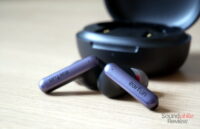The Creative Aurvana Ace 2 are the second model that the company launches with the new xMEMS driver. These are solid-state drivers that promise to revolutionise the market thanks to their super-fast speed and superior transient response, as well as unprecedented low distortion. Let’s see how Creative has made use of them.
Disclaimer: I received a free unit from Creative. The Aurvana Ace 2 retail for $129.99. Additional information on the official website.
TL;DR: recap
| Pros |
Cons |
| + Semi-transparent design (it’s just so cool!)
+ Very good level of detail + Good technicalities |
– Aggressive, overwhelming treble
– Boomy bass – Subpar battery life – No passive isolation – Low comfort – Limited ANC efficacy |
Rating: 6.5/10
Packaging & Accessories
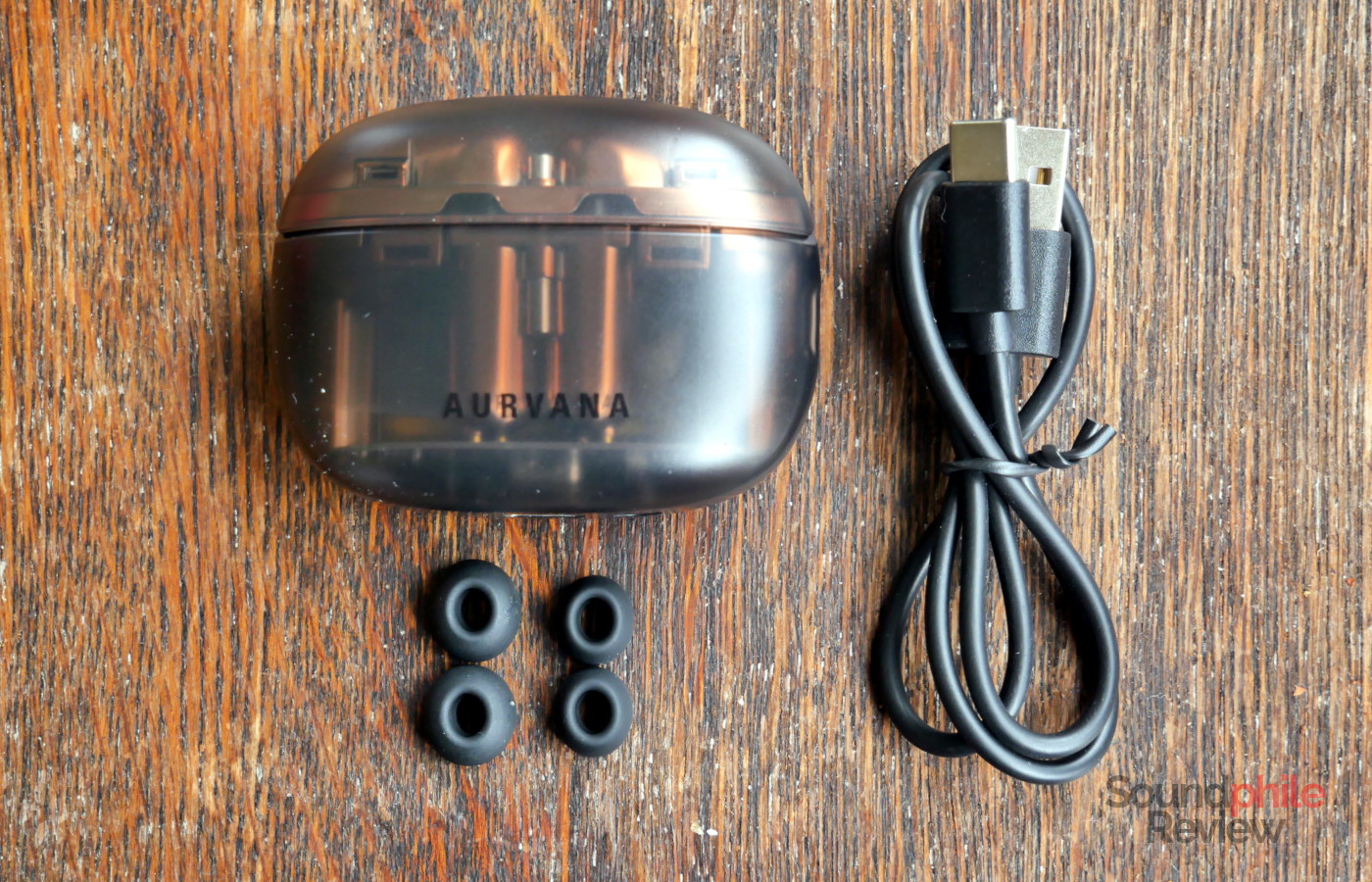
The packaging is rather essential and includes the earphones in their case, a USB cable, a set of eartips and a manual.
Design & Comfort

The Creative Aurvana Ace 2 use a design with a stem, like “classic” earphones (when I was fifteen I used to use Creative earbuds that had a similar design!). The top of the stem has a small metal plate with holes in it, presumably to allow sound to get to the microphones for ANC. The earphones, like the case, are made with semi-transparent black plastic which shows the inside, although the outside of the stem and the inside of the shell (the part that faces the ear) are made of black plastic.
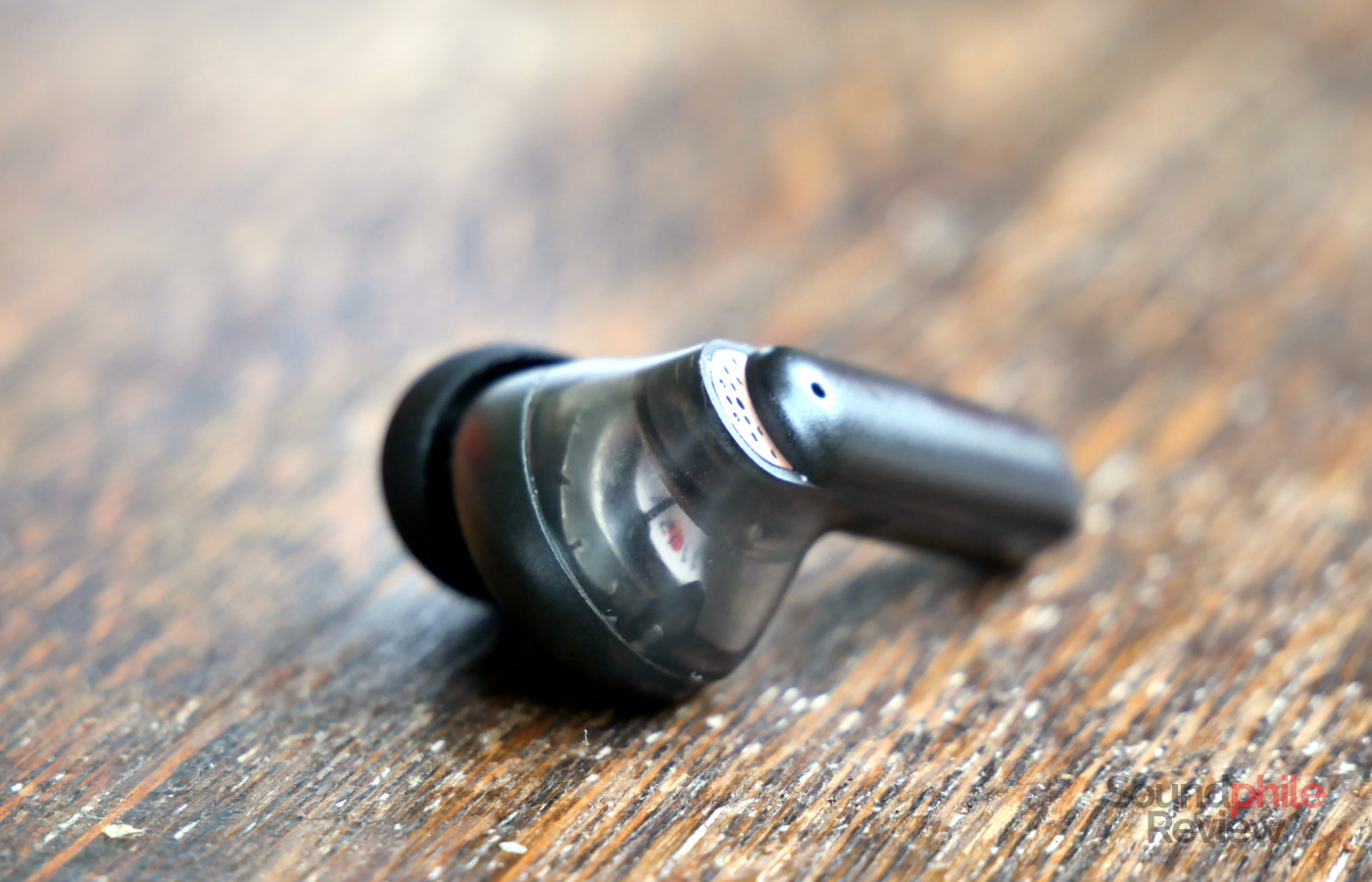
Overall build quality is very high, as is expected from Creative. The earphones feature IPX5 water resistance, which means they can withstand water jets – in other words, they are safe to use while working out or in other conditions where there’s water, though they can’t be submerged.
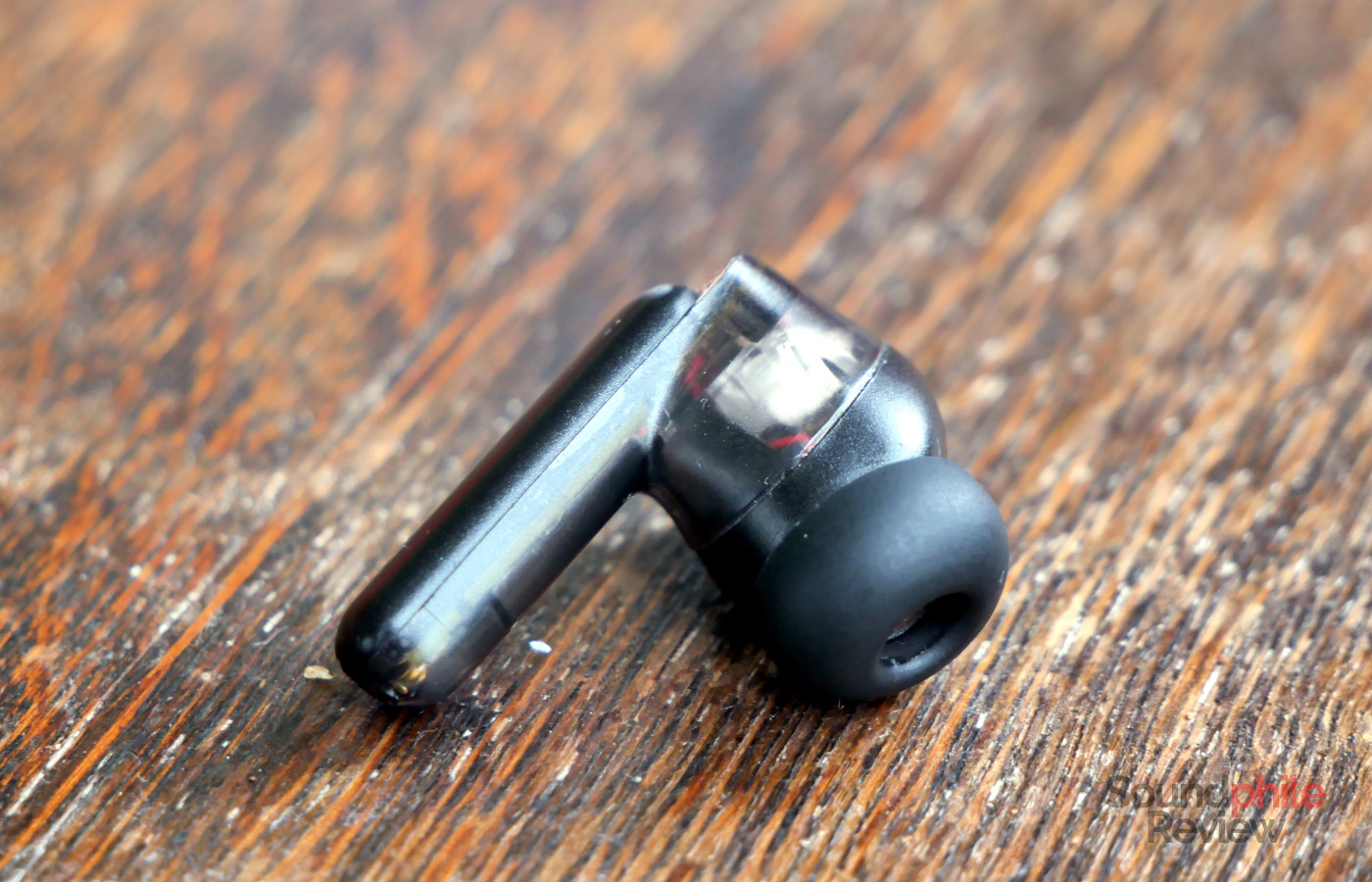
I find the Aurvana Ace 2 quite uncomfortable, independent of what eartips I use. Despite them being relatively small and with curved shapes, they push against the antihelix which quickly becomes fatiguing – and we’re talking about minutes, not hours. In fact, as I am writing this I have been wearing the earphones for about 10 minutes and they have already started feeling uncomfortable! While comfort is an extremely personal factor, and therefore you should take my considerations with a pinch of salt, my ears are relatively large and I often have no issues even with large earphones, to put things into perspective.

Passive isolation is virtually non-existent, which means sounds in the middle and upper region will not be removed by the ANC feature. This is true regardless of what tips you use; even using foam tips leads to the same result. I think this is due to the small grille you can see on the top section of the earphones, which allows the microphones to capture the sounds from outside but also lets them get inside, with the result that there is no isolation whatsoever. In fact, if you disable ANC there is no difference between wearing the earphones and not.

I absolutely love the design of the case, as it is a throwback to the ’90s and early ’00s with their transparent plastic everywhere. The outer shell is a transparent black colour, while the inner one is glossy copper; the result is very elegant while still being a bit of a novelty. It is interesting that you can see the wireless charging spire on the back, as well as the circuit board on the bottom or the magnets in the lid. I’m totally not saying the Aurvana Ace 2 are worth the price just due to the case, but I am also saying it. Jokes aside, the case is very well built and designed, with the lid that is kept closed by magnets while also staying open due to friction. There are a USB-C port for charging and a button to check the charge on the bottom, together with a status LED.
Extra Features & Battery Life
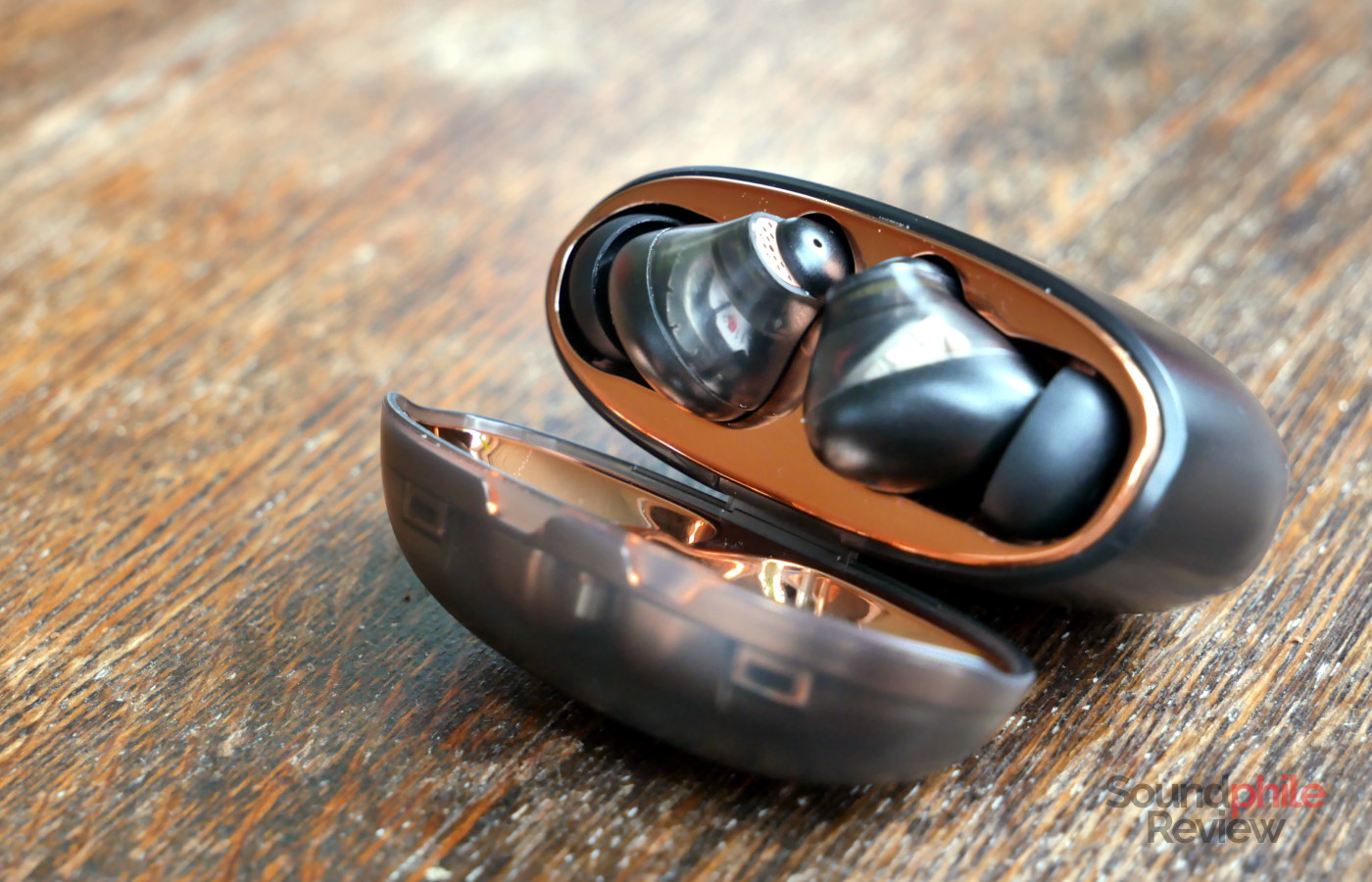
The Aurvana Ace 2 support the SBC, AAC, LC3, aptX, aptX Adaptive and aptX Lossless codecs. The last of those, however, is only available on Android devices with recent high-end Snapdragon processors. It is not possible to use it with other devices and it is not part of the AOSP like the previous aptX codecs, nor it is available with Windows, macOS or other devices. This makes this addition welcome to people who own a compatible device, but overall limited in its impact.
The range and strength of the connection are only sufficient; in my usual test of walking around the house, the music starts stuttering when I’m a couple of metres away from the PC if I turn away from it – not great. One more thing to note is that I have had issues with the connection after the update to the latest firmware version (4.3.240508.1020) as the earphones would connect to my computer, but they wouldn’t “detect” the connection, so they would power off after a few minutes – despite the fact they were actively playing music. This appears to be a bug in the firmware that’s completely random.
The ANC feature is very effective in removing low-frequency sounds: as I am typing this on my laptop, I am sitting on a plane towards a conference and I cannot hear the low rumble of the engine. However, the low-frequency sounds are the only one impacted: I can hear perfectly well the noise of the ventilation system, as well as the voices of all the people around me. The ANC feature is therefore only half useful as it does not allow me to reduce the noise around me significantly enough so that I don’t have to significantly raise the volume of my music, which in the end is the main point of using ANC in the first place. Switching ANC on and off only makes the low rumble of the engines disappear, making the bass in the track slightly more audible, but it doesn’t affect everything else and this means midrange is not more audible at all. One other thing I noticed is that if you move the earphones, as an example to get better comfort, the noise cancellation will drop significantly; in order to restore it you need to turn it off and then back on.
One additional element to consider is that the ANC only has three modes: off, ambient and “adaptive”. There is no way to force stronger or milder ANC and you can only trust the earphones’ programming’s ability to give you the ANC level you want. While this is generally useful, as you don’t have to manually alter the settings when the environment changes, having the option to do so would be very welcome.

Battery life is one of the weaknesses of the Creative Aurvana Ace 2, as it is limited to just 4 hours with the ANC turned on. If you turn it off you can get 6 hours of playback, which is still underperforming in this price range. The case offers three additional charges, bringing the total to 16 hours with ANC enabled. The case also has wireless charging capability.
Software
Creative offers an application which is available to users on both Android and iOS. The app allows you to set the ANC mode as well as to customise the controls and the device name; it also allows you to update the firmware. You can enable the low latency mode, too, in the settings. It is quite barebones overall, with a minimal feature set and interface.
Unfortunately it suffers, at least in its Android version, from a few bugs and glitches. It often won’t detect the earphones even when they are connected, saying that they are not; it also took me almost 10 attempts for it to update the firmware. It sometimes wouldn’t even start the process, hanging at the preparation stage; sometimes it would get stuck at 100%; sometimes it would seemingly succeed, as the earphones rebooted, only for it to say that the update process failed.
Sound
I have tested the Creative Aurvana Ace 2 using a variety of devices, including my laptop computer and my Google Pixel Pro 7 smartphone.
Creative Aurvana Ace 2 |
| Frequency response | 5 – 40,000 Hz |
| Impedance | N/A |
| Sensitivity | N/A |
| Bluetooth version | 5.3 |
| Codecs | SBC, AAC, LC3, aptX, aptX Adaptive, aptX Lossless |
The Creative Aurvana Ace 2 combine a traditional dynamic driver, which takes care of bass and midrange, with an xMEMS driver. This is a novel driver which uses MEMS technology – it is a solid-state driver, manufactured in a way which is very similar to computer processors. The main advantage of this approach is that it uses
There is a constant, relatively strong high-pitched hiss in the background. It is always present, whether you use ANC or not, though it does become stronger whenever you use ANC. When ANC is disabled, it stops after a couple of seconds, probably because the earphone enter a power saving mode and shuts down the amplifier.
Soundstage is decently wide and also has some depth; while it never beats the “music inside your head” feeling, it does offer enough space to make it sound like sound like instruments are distributed around you. Imaging is sufficient, as each instruments has a well-defined placement; however, this placement is limited to the left-centre-right positions and further nuances are mostly lost. Instruments separation is decent in all contexts, though complex and layered tracks show the limits of the dynamic driver.
Bass is decidedly more abundant than perfect neutrality would dictate, especially in the mid-bass region, and ends up often overshadowing the lower mids. This not only adds colouration, but it often ends up sounding bloated and boomy while making the sound as a whole muddy. On the other hand, it is decently deep, with the lower notes which emerge with good enough clarity – see the classic Massive Attack’s Angel as an example. Transient speed is surprising, especially considering bass is being produced by the dynamic driver. Detail is also noteworthy, with many little details emerging clearly. Physicality is worth a mention, too, as the driver is able to deliver that kind of impactful hits which make music more fun.
The mids are overall enjoyably tuned, with a bit of emphasis on the upper region which, however, tends to be overall minor and not affecting the general tonality (not too much, anyway!). Looking at things a bit more closely, there seems to be a small dip in the middle region, however, so male voices appear a bit distant and somewhat hollow – see the aforementioned Angel for reference, as the voices sound distant and muted rather than front and centre. This is not limited to voices, as more generally mids tend to sound relatively distant and de-emphasised, except in the upper region (e.g. electric guitars, trumpets and violins). Take Snarky Puppy’s Minjor: the central piece with the guitar solo (between ~2:00 and ~3:10) has various instruments which often sound muted and lacking vitality. On the other hand, detail is very good, with many smaller details emerging clearly in the mix in not-too-complex tracks; physicality, again, is really good, so drum rolls and hits have carry a physical sensation with them.
Thanks to the high speed of the xMEMS drivers, treble is extremely detailed, with a whole lot of micro-details emerging clearly, even in tracks where you wouldn’t suspect their presence. Let’s take, as an example, Rust, Dust & Guts from the DOOM (2016) soundtrack by Mick Gordon: there are lots of details emerging from the cymbals which I have rarely heard with other headphones. This is the xMEMS drivers showing their prowess and demonstrating what they can really do, which is quite amazing. Contrary to traditional drivers, however, the xMEMS drivers tend to offer more volume as the frequency goes up, and Creative seems to have taken advantage of this to make the Aurvana Ace 2 produce very prominent treble. In fact, treble is almost aggressive as it is significantly more emphasised than the rest; while there doesn’t seem to be any of the sharp, short peaks you often find in balanced armature designs, there is a very large bump around 7 kHz which leads to perceive a generally elevated treble presence which can very quickly become fatiguing. Not only this: this emphasis is such that treble often changes the tonality and makes everything sound tinnier and thinner. As an example, in Stevie Ray Vaughan’s Couldn’t Stand The Weather the emphasis is such that everything appears to be shifted upwards, with bass and the lower region of the guitar itself becoming secondary.
Final Thoughts
My expectations for the Creative Aurvana Ace 2 were very high, mostly due to their use of the xMEMS drivers, so keep this in mind. The level of detail is fantastic, the design is stunning and the technicalities are there. Their tuning is similar to I would define as “mainstream”: emphasised bass as well as treble, with recessed mids. One possible issue, if you are sensitive to treble, is that it is far more present than anything else, which could limit the possible audience. The level of detail is very good, especially in the treble region – but we’ll talk more about sound in a moment. From a functional perspective, the Aurvana Ace 2 offer a lot of features like wireless charging, ANC and persistent EQ, but on the other hand they also feature mediocre battery life, a total lack of passive isolation (which, in turn, hampers ANC) and poor comfort (though, again, this is highly subjective). The availability of aptX Lossless, while welcome, is limited to a few devices, which puts a boundary to its usefulness.
Given these are among the very first earphones to feature the xMEMS drivers, I feel it necessary to spend a few words on this. These drivers offer an absolutely stunning sound which is superbly detailed and, almost more importantly, perfectly linear, save for treble where their SPL goes up. xMEMS does market their drivers as a replacement for balanced armature tweeters, so Creative’s choice to use them this way doesn’t surprise; what is a bit puzzling is the point where they placed the crossover: why use the drivers for the only region in which they don’t offer a linear response? Why use a traditional dynamic driver, which is intrinsically not linear, for midrange? I can understand the reasoning for bass, as dynamic drivers can be made linear enough there and also offer physicality which xMEMS drivers don’t. However, the choice to use the latter only for treble seems to confine them to a secondary role. It is doubly puzzling given Creative chose to emphasise treble more, or rather in a different way, than the xMEMS drivers would naturally do, rather than making them flatter.
Overall, I find the Aurvana Ace 2 a very mixed bag. The general theme seems to be that the features are all halfway there: linearity, ANC, passive isolation, battery life… Everything seems to be very well done, but at the same time lacking one thing or another. The xMEMS drivers show that this technology holds a lot of promise, but at the same time it shows how the driver tech itself does not lead to great sound. The Aurvana brand seems to target audiophiles, or at least people who are more conscious about sound quality, but the result in terms of sound signature is closer to that of the much cheaper Zen Air Plus than to that of high-end, linear IEMs. While that is not inherently a bad thing, it doesn’t compensate for the shortcomings in the other areas, either, which is why I find it hard to recommend the Aurvana Ace 2 to everyone. It is a very interesting product for early adopters who aren’t afraid of experimenting, though!











